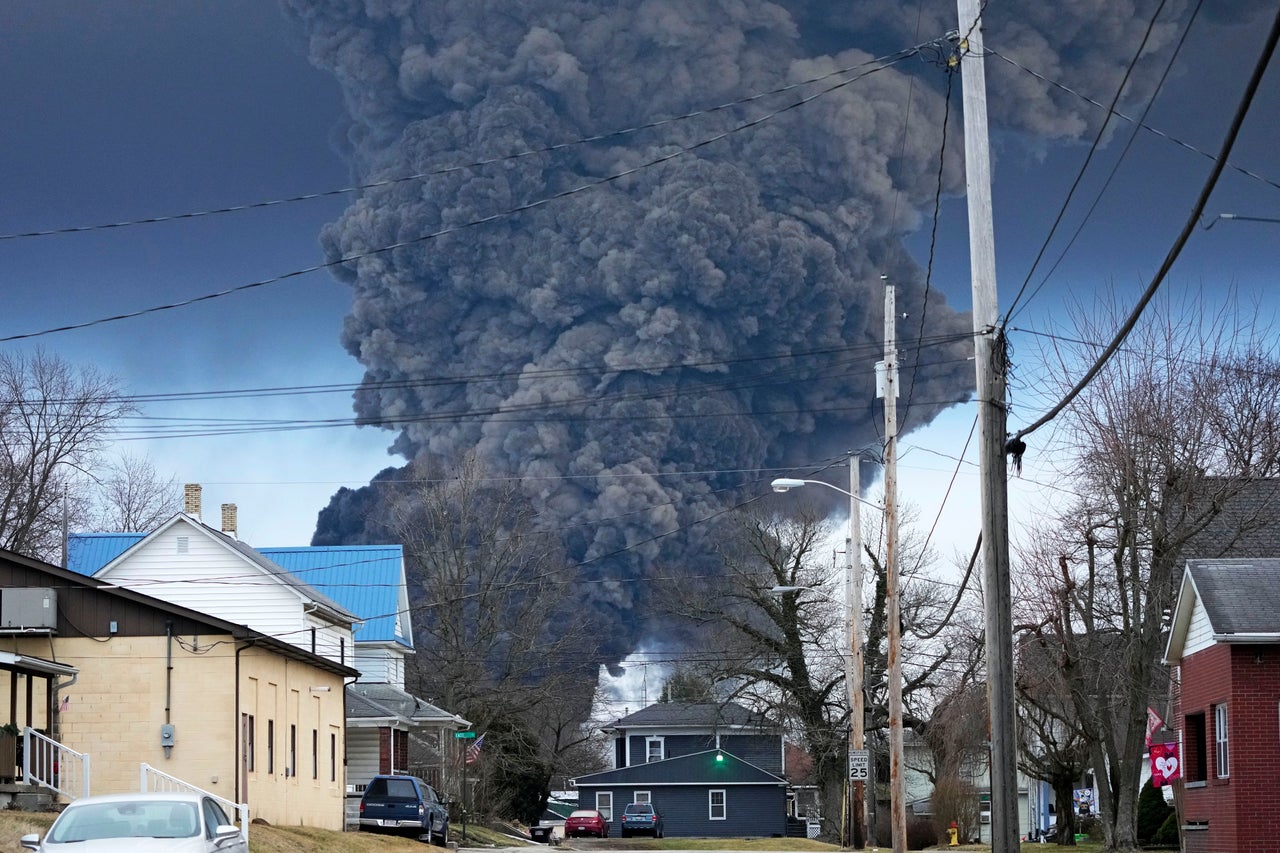Shortly after entering the field of public health in the early 1970s, Stephen Lester learned there was one thing he should steer clear of studying: how exposure to multiple chemicals at once might be devastating human health.
It was nearly impossible to secure government grant money for mixture studies, due to monumental hurdles in interpreting the results and ultimately determining which chemicals might have caused any documented health issue. If, for example, you exposed a rat in a lab to seven chemicals and the rat developed cancer, you could conclude the mixture causes cancer but are no closer to being able to say which toxin or combination of toxins was responsible. Researchers didn’t bother submitting grant applications to do such work.
Little has changed in the 50 years since. Few mixture studies receive funding, and very little data on the effect of chemical mixtures exists. And when disasters strike, scientists assess risk the way they’ve been doing it for decades: one chemical at a time — even though the reality is that people are often exposed to a cocktail of different chemicals.
“You have these risk numbers, and they’re all driven by one chemical exposure at a time,” said Lester, a toxicologist and the science director for the Center for Health, Environment and Justice. “Those numbers don’t have any reality in the world, but yet if you talk to the best scientists in the world, they’ll say that’s what we have to use because that’s what we’ve got.”
In communities like East Palestine, Ohio, where residents were exposed to potentially dozens of different chemicals following the fiery derailment of a Norfolk Southern train in February, environmental agencies are often quick to declare the air, water and soil safe, despite having little grasp of how substances could be interacting to harm human health.
“We really know just short of nothing about this, and yet we are making statements to the public that it’s fine,” Lester said.
“All the work that we’ve done, all the science that we know, is not enough.”
‘Something From Nothing’
The Norfolk Southern train careened off the tracks Feb. 3 while hauling toxic materials, including hundreds of thousands of pounds of vinyl chloride, a common organic chemical used in the production of plastics that has been linked to several types of cancer. Fearing a potentially catastrophic explosion, the railroad and local authorities temporarily evacuated people in the immediate area, and intentionally vented and burned the vinyl chloride, releasing a thick plume of toxic smoke into neighboring communities.
Since then, the Environmental Protection Agency (EPA) has repeatedly stressed there is little cause for concern, even as residents have continued to report a myriad of lingering health impacts — nose bleeds, headaches, respiratory problems, rashes and irregular menstrual cycles — that they are convinced are linked to the derailment. The agencies’ determination relies on testing that, for the most part, has found individual chemicals, including vinyl chloride and benzene, at levels below minimal risk thresholds.
Yet the danger in East Palestine may not be any one chemical but several working in tandem. And the fields of toxicology and epidemiology remain largely incapable of investigating and understanding that threat.

Linda Birnbaum, a toxicologist and former director of both the National Institute for Environmental Health Sciences and the National Toxicology Program, said the scientific community very rarely tries to investigate the totality of exposure during such disaster events. The most toxic chemicals — those known to cause cancer and other serious health impacts — often dominate a response effort, for obvious and practical reasons. Occasionally, health experts will look into the risk of exposure to broad classes of chemicals, such as dioxins or volatile organic compounds (VOCs), but Birnbaum said she “can’t think of any time where people have tried to put it all together.”
Mixtures are a complex problem that has long frustrated the field of toxicology, Birnbaum said.
“We know there are times you get something from nothing,” she said. “By that I mean you can have lots of chemicals present which, if they were by themselves, you’re not going to see any response, but put them together and you do. And we have not gotten very good at doing that.”
HuffPost was unable to find recent data on the percentage of toxicology resources that go to studying chemical mixtures. In a 2005 research article, science writer Emily Monosson noted that “a limited review of 151 papers published in 1992 suggested that some ‘95% of the resources in toxicology is devoted to single-chemical studies.’” Lester expects that figure hasn’t changed much. Though government agencies have increased efforts to investigate mixed chemical exposures, primarily in response to public criticism, the progress has been limited, he said. Single-substance research still dominates.
EPA and other public health agencies operate under the assumption that multiple chemicals have an additive effect, meaning the toxicity and negative impact can be added together proportionally. But there are various examples of what’s known as synergism, when chemicals combine to have an effect above and beyond what you’d expect from just adding them together. On the flip side, the opposite can occur: One chemical could potentially dampen the impact of another, a phenomenon known as antagonism.
EPA says it immediately reached out to the Agency for Toxic Substances and Disease Registry (ATSDR) following the derailment to establish short-term, intermediate and long-term action levels that are “very conservative and take into account risk to sensitive populations (e.g., young children, elderly, etc.).” To date, sampling has found chemical concentrations at levels that “pose a very low risk to human health,” an agency spokesperson said via email.
“EPA uses peer-reviewed published data to derive our risk levels,” the spokesperson said. “We acknowledge that more research is needed to increase our understanding of cumulative impacts from chemical mixtures, and that this is a complex and evolving science. In order to be as protective as possible of human health, EPA uses the risk-based science that’s currently available to us and assumes that the effects of individual chemicals are additive during an exposure to a chemical mixture.”
EPA and a small army of Norfolk Southern contractors have monitored for a myriad of individual chemicals, but there has not been — and there are no current plans for — a more thorough assessment to determine if numerous chemicals, at low levels, could be wreaking havoc on residents’ health.
What’s happening in East Palestine has played out at contaminated site after contaminated site. Take Toms River, New Jersey, where for decades chemical corporations Ciba-Geigy and Union Carbide dumped toxic waste into the ground and water, contaminating the drinking supply. The legacy of industrial pollution was believed to be responsible for a spike in childhood cancer in the 1980s and ’90s.
In his Pulitzer Prize-winning book, “Toms River: A Story of Science and Salvation,” author Dan Fagin writes that one state official had advocated for a thorough, cumulative risk assessment of all toxic chemicals present at the site, but the New Jersey Department of Environmental Protection “nixed the idea.”
“Understanding the toxicity of SAN trimer” — the primary contaminant that tainted the town’s drinking water — “would be hard enough without also trying to assess the combined impact of more than one hundred other chemicals at low levels,” Fagin writes, adding that that decision “shifted the Toms River studies even farther away from the complicated reality of the town’s environment.”
“We don’t know or have much of an understanding at all about what happens to people exposed to multiple chemicals in a situation like that. So what they should be doing is moving everybody out of there who wants to go. That would have been the right thing to do because of a lack of understanding.”
- Stephen Lester, science director at the Center for Health, Environment and Justice
Much like Toms River, East Palestine has been left with an incomplete picture of the threat it faces.
If the EPA and other public health agencies were being honest, Lester said, they’d acknowledge that they do not know the true exposure risk in East Palestine.
“That is the reality here. We don’t know or have much of an understanding at all about what happens to people exposed to multiple chemicals in a situation like that,” he said. “So what they should be doing is moving everybody out of there who wants to go. That would have been the right thing to do because of a lack of understanding.”
Scientists are well aware of the knowledge gaps related to chemical mixtures, while disaster response officials at times go out of their way to avoid talking about it. People might demand resources to relocate if they understood that experts don’t know the full extent of the risk in East Palestine, Lester said.
“People are going to say, ‘Well, you can’t leave us here then. You can’t let us sit here and suffer,’” Lester said.
Some have already made such demands.

Acknowledging Unknowns
This month, several East Palestine residents spoke on a panel during a public health workshop on the chemical disaster in their community and voiced their frustration with feeling abandoned in a town they are convinced is unsafe.
“It is a worry for me that this is going to trigger something that we are going to have to deal with for the rest of our lives,” said Zsuzsa Gyenes, a mother and resident of the village, located along the Ohio-Pennsylvania border. “And it just feels like nobody in charge wants the answers.”
There are many gaps in scientific data that make answering such questions difficult, even for certain individual substances. For some chemicals, including vinyl chloride, EPA and other public health agencies have a firm understanding of potential health hazards, and have established exposure safety limits. Others involved in the derailment, however, are more of an enigma.
Weihsueh Chiu, a Texas A&M professor, detailed some of the challenges with estimating and communicating risk at the two-day workshop. He highlighted that three chemicals involved in the derailment — Diethylene glycol, isobutylene and ethylhexyl acrylate — are known to be hazardous to human health but do not have toxicity values or safety thresholds, and Chiu said there are often gray areas between what is considered a “safe” and “unsafe” chemical exposure.
“It can be challenging to communicate this type of continuum of risk, particularly in the disaster setting,” Chiu said. “Most people, they really just want to know ‘Can I drink the water? Can I breathe the air?’”
Of the more than 85,000 chemicals that exist today, only a small fraction — 1%, according to one estimate — have undergone toxicity studies.
The gray area becomes bigger when several chemicals come into play. Certain pollutants target the same parts of the human body, meaning several individual chemical exposures at levels considered “safe” could cause serious damage to the liver, kidneys or respiratory system. Complicating things further is the fact that individuals respond to chemical exposures differently, based on factors such as underlying health issues, diet and stress.
Keeve Nachman, a toxicologist and associate professor at the Johns Hopkins Bloomberg School of Public Health, said the issue is not that toxicologists aren’t interested in knowing how chemicals interact to cause disease.
“It’s just that it’s very difficult to study,” he told HuffPost. “Even in an animal study where we can control all the variables, the second you add a second chemical it becomes much more complicated. You’ve got to make decisions about how much of the first chemical dose do you give in this animal, versus the second chemical. And going beyond two chemicals, the complexity starts to increase exponentially.”

At the workshop about East Palestine, Nachman and others stressed that public health officials need to be transparent about what they do — and, critically, what they don’t — know about risks from chemical disasters.
“That’s a challenge sometimes,” said Patrick Breysse, an environmental health sciences professor at Johns Hopkins and former director of the CDC’s Agency for Toxic Substances and Disease Registry. “But you have to have a commitment to doing both those things.”
Lester argues EPA has dropped the ball on communicating what they don’t know in East Palestine.
“No one in East Palestine was exposed to a single chemical,” he said. “People were exposed to multiple chemicals, many of which affect the same target organ, such as the central nervous system, or the upper respiratory system. Scientists have no way to assess the health impacts from exposures to multiple chemicals. This should be obvious from the real world response that we are all seeing in East Palestine where people continue to report adverse health symptoms such as headaches, bloody noses, difficulty breathing, and more.”
“Instead of acknowledging how little we know and understand about the adverse health effects caused by simultaneous exposure to low level mixtures of toxic chemicals, EPA instead releases disingenuous and misleading statements … in a false attempt to convince people that everything is all right,” he added.
‘That’s Not Science’
One of the primary concerns in East Palestine is dioxins, a class of chemicals linked to numerous serious and potentially deadly health problems.
The federal cleanup threshold for dioxins hasn’t changed since the late 1980s, even though EPA’s own research indicated that it should.
EPA considers dioxin concentrations below 1,000 parts per trillion in residential areas to be safe. But in 2010, after a multiyear scientific review, the EPA under President Barack Obama recommended drastically lowering cleanup thresholds, to 72 ppt in residential soil and 950 ppt for industrial sites, and even considered lowering them to a mere 3.7 ppt and 17 ppt, respectively. The administration never moved forward with the draft recommendations, effectively walking away from its own science.
Dioxins are known to form when chlorinated chemicals like vinyl chloride combust. In East Palestine, EPA has stressed that dioxin concentrations have mostly been found at “low” levels, anywhere from 1 ppt to 20 ppt, however, some readings exceed the thresholds from the agency’s draft recommendations in 2010.
For Lester, EPA’s handling of dioxins, both in East Palestine and generally, highlights that the current system for assessing chemical risk is broken, favoring corporate interests over public health.
“You can’t have it both ways,” he said. “You can’t just use the numbers you like, because clearly that’s not science.”
“I don’t know that we’ll ever be in a position to know precisely how quantitatively all of these things work together...That doesn’t mean that we can’t solve the problem without those precise estimates. I think that’s where the focus really needs to be: How do we manage the risk in light of tremendous uncertainty?”
- Keeve Nachman, associate professor at the Johns Hopkins Bloomberg School of Public Health
Lester and others are pushing for public health agencies to think more broadly about what can be done to protect communities in the absence of scientific knowledge about chemical interactions. That could include creating programs, similar to the federal Superfund program that deals with cleaning up the nation’s most toxic and hazardous sites, to relocating residents from disaster-stricken communities and funding long-term health care costs, Lester said.
There are cases where Lester believes the government and Congress took a much more protective approach. Under the Agent Orange Act of 1991, Vietnam veterans do not have to prove that certain diseases were caused by exposure to the toxic defoliant in order to qualify for benefits and compensation. With the Honoring our PACT Act of 2022, Congress applied that same model to veterans exposed to toxic burn pits overseas.
Lester argues communities like East Palestine shouldn’t be held to a different standard, given the many unknown risks of the exposure event.
“Somebody in a position of power has to acknowledge that, ‘Hey, we don’t know the science here. We just can’t figure this out and so we are going to take some steps here to protect these people,’” he said.

There are a number of emerging tools aimed at better assessing the risks of mixed chemical exposures, including in vitro methods that expose human cells to chemicals in a lab. The National Institute of Environmental Health Sciences in 2010 formed a working group of scientists dedicated to advancing chemical mixture studies, and funds a program for such research.
But the reality is that science is a long way from understanding the cumulative impacts of chemical mixtures. Nachman agrees that existing data gaps shouldn’t prevent public health agencies from taking action to protect public health.
“I don’t know that we’ll ever be in a position to know precisely how quantitatively all of these things work together. The amount of money it would take and time — it’s infinite,” Nachman said. “That doesn’t mean that we can’t solve the problem without those precise estimates. I think that’s where the focus really needs to be: How do we manage the risk in light of tremendous uncertainty.”
The goal of risk management is not to direct people how to act, but instead empower them with information, Nachman explained at the workshop.
“We can’t tell people what to do. We don’t know what’s best for people,” he said. “But we can advise them of what we know, share what we don’t know, and do our best to help them make the best possible choices under their particular circumstances.”
When asked whether officials responding to the East Palestine chemical disaster have clearly communicated to the public what they do not know, and whether community residents have been left with a false sense of security, Breysse steered clear of issuing a judgment. But he said that in his experience with disaster situations, public health officials often don’t clearly articulate the many uncertainties.
“What that means is you leave the door open for somebody to say, ‘Well, therefore there is no concern,’” he said. “Not knowing is not the same thing as saying there is not a concern.”
“It’s not black and white. It’s not yes or no,” Breysse added. “And if you’re not careful about doing that, I think that’s when you leave the door open for somebody to say, ‘Don’t worry, they said there is not a problem.’”
During a visit to East Palestine less than three weeks after the derailment, EPA Administrator Michael Regan joined Ohio Gov. Mike DeWine (R) and others in drinking tap water from residential homes — a stunt reminiscent of President Barack Obama’s during the water crisis in Flint, Michigan.
The officials cheered glasses. “That’s good,” Reagan declared after taking a gingerly sip.
“That makes us feel better,” the homeowner replied.
Public trust ultimately crumbled in the wake of Reagan’s visit, as residents learned of flawed and inadequate testing and numerous perceived conflicts of interest, as HuffPost previously reported.
Lester, who has repeatedly condemned EPA’s response in East Palestine, reflected on a decades-old paper that, for him, helps explain the agency’s handling of the disaster.
Published in 1987 and titled “Truth and Consequences: Health Agency Responses to Environmental Health Problems,” the paper concludes: “One of the conspicuous casualties in the war against toxic wastes is the public’s regard for public health officials. More often than anyone would like, frustrated and concerned citizens have received little sympathy, understanding, or help from local, state, or federal health agencies. Instead, officials have tried to minimize public concern, often irrespective of the situation. Departments of public health have become departments of public reassurance.”
